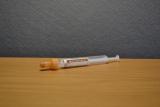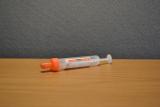Test Directory
Amylase
Containers - Adult

Brown Cap, Gel Clotted
|
Volume Range
0.1 ml
Additive per Container
None |

Orange Cap
|
Volume Range
0.1 ml
Additive per Container
Lithium-heparin |
Containers - Child

Orange Cap - Paediatric
|
Volume Range
0.07 ml |
Reference ranges
0 - 100 U/L
Birth - 6 months: 0 - 80 U/L
6 months - 16 yr: 24 - 110 U/L
>16yr 3 - 100 U/L
Many studies have demonstrated ethnic variations in amylase reference intervals with values in African and Asia patients being higher than our locally quoted ranges.
Laboratory Site
Old Dalkeith Road
Edinburgh
EH16 4SA
Howden
Livingston
West Lothian
EH54 6PP
Edinburgh
EH4 2XU
Anticipated turnaround
1 day
General additional information
Macroamylase
What is macroamylase?
Macroamylase is an immunoglobulin-amylase complex that forms in the circulation and cannot be adequately cleared by the kidneys. This causes benign increases in amylase concentrations. It is estimated that this affects 1-2% of the population. The causes are unclear but there is an association with autoimmune conditions, chronic liver disease and some medications.
When should I suspect a patient has macroamylase?
Typically amylase concentrations remain fairly stable in a patient with macroamylase. Unchanging raised amylase results that are inconsistent with the clinical picture should raise the suspicion of macroamylase.
How can I investigate for macroamylase?
There is no easily available test for macroamylase. If you wish to exclude a pancreatic pathology request a lipase on a serum (brown topped) sample. This is sent to an external laboratory and a result will not be available for several days. A normal lipase result with a corresponding raised amylase would be suggestive of macroamylase or a raised salivary amylase. Increases in salivary amylase are typically associated with salivary disease (eg mumps), ectopic pregnancy, lung disease, tumours and alcohol abuse. Anorexia, particularly when associated with vomiting has also been seen to increase salivary amylase.
Paired urine and serum amylase can be a useful tool to determine the likelihood of macroamylase. High levels of amylase in the blood are secondary to reduced clearance rather than excessive production and consequently serum amylase is high and urine amylase is low, leading to a low amylase clearance. The following clearance calculation can be used, with a clearance of <1% being highly suggestive of macroamylase and >5% effectively excluding it.
Urine amylase x Serum creatinine (mmol/L) x100%
Serum amylase x Urine creatinine
There are no UK labs currently measuring macroamylase or salivary amylase directly.